MASS DEPORTATIONS
TO NAZI GERMANY, SOVIET UNION, AND THE EXODUS FROM
KRESY
Introduction
The deportation of Poles by both the Nazis and the Soviets was one of the greatest forms of crimes against humanity, genocide and ‘ethnic cleansing’ to befall upon the Polish nation during the Second World War. A hint or prelude to the future policies of the Nazis emerged in 1938 when the violent expulsion of 17,000 Polish Jews between 28th and 29th October in Leipzig, Saxony took place (also known as the “Polenaktion”) (Larkey, 2017) and largely ignored by leading global politicians and a ‘muted’ international press (Schneidermann, 2020). The Ost Jews were forced over the border at Neu-Bentschen/Zbąszyń, Konitz or Bytom. In Paris, Herschel Grynszpan, a refugee took matters into his own hands in a retaliatory action. He assassinated a diplomat, Ernst Von Rath from the German embassy that the Nazi’s used as a pretext for implementing the ‘November Pogroms’ (Kristallnacht).
While Treuhandstelle Ost saw the mass confiscation of Poland’s resources, businesses, industry and agriculture, the Nazi claim that Poland no longer existed, is challenged by Maciej Jan Mazurkiewicz’s (2021) study on international law. He argues that the German’s were still obliged to observe legal norms in its relations with Poland despite the occupation.
The Soviet invasion in 1939 was under the pretext of protecting the ethnic minorities in Eastern Galicia since the Polish Government had collapsed (Kochanski, 2012; Rogalski, 2017) even though the Polish Government had relocated to its south-eastern border with Romania (Williamson, 2009). Defending the eastern frontier was an army of 100-150,00 troops poorly armed and largely made up of reservists and members of KOP, the border militia who fought on since there was little option in negotiating a safe passage to Romania (Williamson, 2009). Voroshilov’s ‘Lightning War’ may not have met widespread Polish defence; however, the Soviets met some significant engagements that highlighted overconfident leadership, poor planning, and inadequate logistical support (Hill, 2014). While the Soviet army had been partially mobilised, the speed of the German advances shocked the Soviets (Moorhouse, 2019) and highlighted their inadequate military preparations for the impending conflict between the Soviets and the Reich (Suvorov, 1990).
The Soviets still ‘smarting’ from the defeat in 1921, started to undermine the Treaty of Riga by passing a resolution at the Cominton’s 5th Congress for East Galicia to be incorporated into the Soviet Union (Rogalski, 2017). The regional Commissar, Josef Stalin tried to cover his failings in the defeat through using Lord Curzon’s proposals as a cover for political manipulation within the region (Rees, 2009). After 1921 specially trained groups of Ukrainian and Belorussian Bolsheviks and Red Army soldiers slipped over the Polish-Soviet border to attack local police stations and local administrators, causing damage until the formation of the KOP in 1924 restricted activities of the incursions (Komaniecka, et al, 2013). The deportations started on 10th February 1940 and the NKVD had pre-drawn up lists of families covering local government, army and KOP, forestry, Kulaks, and railway employees that totalled around 140,000 people. More deportations were planned to empty the kresy of ethnic Poles and repopulate with Ukrainians and Belarusians sympathetic to the Soviets.
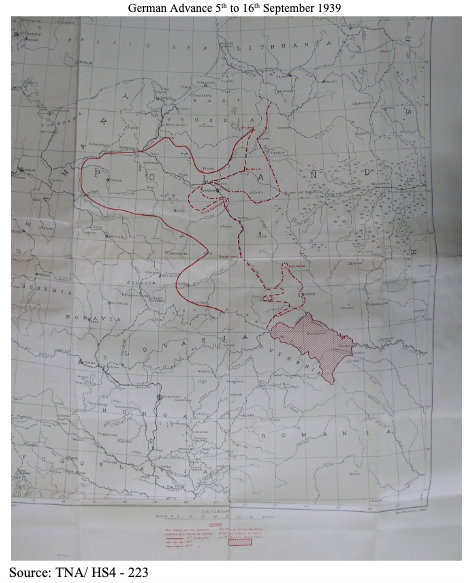
Nazi Deportations:
The Nazis saw Poland as a large ‘reservoir’ of labour whose policies towards Poland became clearer as the early stages of war progressed. The ruthless suppression of Polish culture was deemed by the Nazis that as slaves, the Poles needed no culture or entertainment (Kochanski, 2012) despite Mazurkiewicz’s (2021) study challenging this assumption. The wholesale economic exploitation ranged from seizure of raw materials, dismantling of factories that was subsequently revoked, and quotas for industrial and agricultural output under Treuhandstelle Ost. The industrial, commercial, property and agricultural businesses became transferred to German ownership. The slump in the value of the German issued złoty created rampant inflation and imposed a level of poverty not seen since the Great Depression. Nothing was safe from confiscation.
The Wehrmacht was responsible for 694,000 Polish POWs housed in terrible conditions in Germany and Poland that later would be used to create the future POW camps made up of wooden huts for the French and British POWs while the Poles were largely accommodated in tents. The excuse for their poor treatment and breaches of the Geneva Convention was that Poland no longer existed and therefore no longer covered by international laws (Kochanski, 2012). The fate of Jewish POWs was far worse and given the harshest treatment and labour duties that resulted in 25,000 had perished by the spring of 1940 (Kochanski, 2012).
In the spring of 1940, the Poles were released and became slave labourers mainly to fulfil quotas to replace agricultural labourers, construction workers, factory workers, and miners. Only senior ranks remained incarcerated. Due to crippling inflation and unemployment, 20,000 Poles ‘volunteered’ for labour in Germany in 1940 (Kochanski, 2012). The quotas for labour meant almost 1 million were still needed of which the majority would be taken from the General Government of which 75% were women. Up until 1943 when conditions started to improve, 130,000 Poles died of maltreatment in German (Kochanski, 2012).
The Volksdeutsche or Poles of German descent were rapid in their claims to property and land in annexed areas: Danzig-West Prussia and Warthegau where they were a minority within the local population. The expulsion of Poles into the General Government (Generalgouvernment) in unheated railway trucks from 1939 until 1940 caused pressure on the Reich’s economic development plans for the region (Eberhardt, 2011; Mędykowski, 2018). On arrival in the General Government, little had been prepared for their arrival and Governor Frank asked for a temporary halt until the spring of 1942. These deportations included Polish Jews who were transported directly to the ghettos in major cities.
Claiming German ancestry may have given some temporary advantages, however the ‘sting in the tail’ through meeting the conditions of the Volksliste was conscription into the Wehrmacht which started in late 1941. By January 1941 over 500,000 Volksdeutsche had been rehoused with the majority in temporary SS run transit camps (Kochanski, 2012) with the Germanization of Poland continuing relentlessly with Polish cities being renamed and land occupied (Eberhardt, 2011).
The daily threat of “łapanka” or roundups for forced labour, destabilised whole communities if labour quotas were not met. These daily occurrences were random, and most detainees were sent to Germany as slave labour, however in some cities these were arrests, held to ransom or sent to local labour camps. In the Jewish ghettos, this was the ‘death sentence’ for transportation to the concentration camps. By 1943 there were nearly 1m Poles working for the Reich in appalling conditions that had depleted the ‘reserves’ in the General Government (Kochanski, 2012) and marginalising Hans Frank’s ability to meet quotas. By the end of the war some 2.8m Poles were working in factories and farms (Eberhardt, 2011) and forced to wear a ‘P’ to signify their ethnic origin and all in the name of the ‘final victory’.
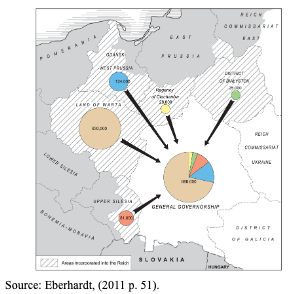
The economic policy towards the General Government was dependent upon the state of a war crippled and stagnant economy since 1939. Work simply did not exist. The SS took advantage of the Jews through roundups and confiscation of property and businesses, creating their own economy within the economy that generated huge profits for them (Mędykowski, 2018). The approach to economic planning for the General Government was based on ‘colonialisation’ and provision of labour, raw materials, and agricultural products to support the Reich. The industrial base was earmarked for military production and Hans Frank, the Governor did not resist so that when the Governor General Regulations of 15th November 1939 were issued, there was a wholesale confiscation Polish state assets and the plundering of raw materials, products, and business with impunity. The regulation was amended in January 1940 to cover the confiscation of personal property for public purposes (Mędykowski, 2018). Initially, much effort was put into repair and upgrade of roads, bridges and the rail network destroyed during the invasion including the brewery at Żywiec. The agrarian economy was low in productivity with farming techniques and practices almost dating back to medieval field systems that required huge investment and modernization that would expedite the General Government’s ability to meet quotas.
Experimental schemes to depopulate Poland and replace them with ethnic Germans was carried out in the Zamość region with 10,000 Germans occupying vacated land as part of the Generalplan Ost (Kochanski, 2012) which resulted in the AK ordering villagers to destroy their property. The German action and process were not handled well. In 1943 the level of lawlessness forced Governor Frank to replace officials to stabilize the region and focus on productivity. Repopulating former Polish territory continued up until September 1944 when the 1st Byelorussian Front finally threatened the Reich that was now retreating westwards. The map below gives an idea of the ethnicity and origins of the Volksdeutsche and demonstrates the geographic movement of displacement to meet the demands of the Nazis indoctrination.
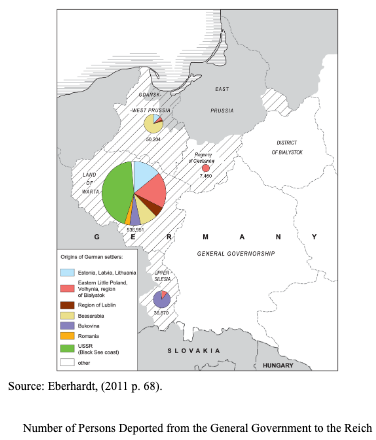
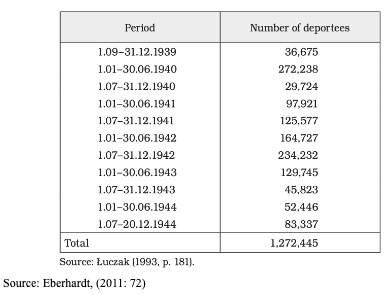
The deportation process attempted to achieve an ethnically ‘pure’ Germany and casting the Polish population including the Jews, into a ‘reservation’ and isolation likened to the pogroms in the USA in dealing with indigenous populations. The setting up of the General Government in Poland was violent, wrenching families from their ‘homeland’ and usually splitting up families for what was being prepared for enslaving the population for the Reich.
The distribution of deported workers in the Reich gives an indication of the pending issue of DPs in the immediate post war period that the Allies and the IRC had to deal with.
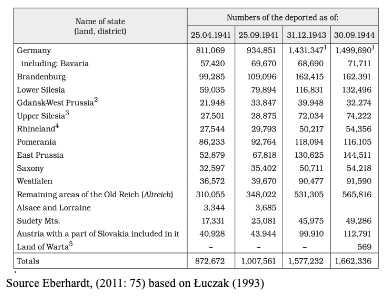
The post war Polish government had to decide and define who was a German and not an easy task. Kochanski (2012) highlights the issue through identifying that in East Prussia the indigenous inhabitants being made up of Mazurs, Kashubs and Warmiaks could fall into either category resulting in a complexity of decisions over deportees and DPs.
Soviet Deportations 1940 – 1941:
On 10th February 1940 the first deportation using 98 trains transported 150,000 members of families to Archangelsk, Sverdlovsk, Omsk, Novosibirsk, and Irkutsk to Posiolki (family work camps), collectives (kolkhoz), construction projects and lumber camps (Jolluck, 2002). Age and state of health were ignored and had to endure unbearably harsh conditions in cattle trucks with minimal provision of food and sanitary facilities leading to deaths while in transit (Ptaśnik, 2003). The first deportation was of the ‘settlers’ who occupied the eastern provinces after the disastrous Polish-Bolshevik war for the Soviets and the deportations were seen as retribution. The eastern border lands or ‘Kresy’ had been occupied by those of political and economic privilege (Eberhardt, 2011; Linkiewicz, 2014; Shimomura, 2022) and had been disputed since 1919 (Ciancia, 2019) as the Russian empire collapsed and not resolved at the Treaty of Versailles in June 1919 after the Paris Peace Conference where the Curzon Line had first been mooted. Only 142,000 arrived at their camps after being in transit for over a month. Poles made up the majority deportees (81.7%), Ukrainians (8.8%) followed by Belarussians (8.1%) and mainly came from south-eastern Poland (Eberhardt, 2011). Future deportations might take two weeks or a month and with it a ‘garrison’ of badly needed soldiers for the defence of the Soviet Empire that saw somewhere between 200,000 to 300,000 to manage the cumbersome, inhumane, and corrupt system (Jolluck, 2002).
According to Eberhardt’s (2011) research the deportations numbered the following and stopped only after the German invasion of Russia:
- November 1940 - 137,351
- 1st January 1941 - 137,132
- 1st April 1941 - 134,491
- September 1941 132,463
The majority of these deportations were sent to Arkhangelsk district and Krasnoyarsk. The following table gives a breakdown of locations.
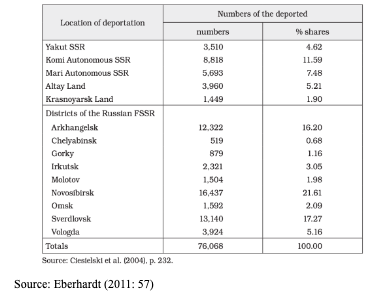
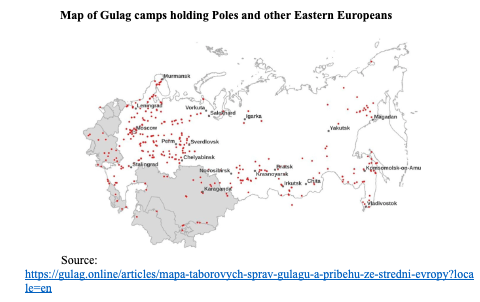
The overall status of deported Poles is summarised in the following table and gives a good insight into the ratios and repression of POWs and deportees from where they originated:
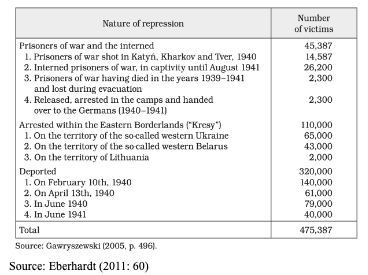
Amnesty was granted on 12th August 1941 through the efforts of General Władsław Anders that started a drift south towards the Caspian Sea to Iran with about 30,000 civilians in transit that was poorly organised and completed in 1942. Some 10,000 were left behind for a variety of reasons. Personal memoires describe the chaos and hardship coupled to high levels of disease and malnutrition that accompanied them to freedom. The survivors had endured hard labour and meagre rations with forced sex, ‘marriage’ of children and rape being a common practice sometimes in exchange for food and yet some violent acts were omitted from personal memoires to avoid bringing shame on families (Ciesielski, 1999; Jolluck, 2002). The impact of hard labour on the women who worked from dawn until 21.00 hours, the physical and psychological debilitated effect on the women was to such extent that individual and collective identities suffered. The women were simply a ‘resource’ to be exploited by the Soviet system and were treated no differently to men (Jolluck, 2002) that broke social and economic norms in a brutal way.
Despite the amnesty, the transit to Polish reception camps in Soviet Russia faced delays, trains re-routed and forced to work on collective farms in Kazakhstan, Kirghizia, and Uzbekistan before their release and transport to their final destination in Pahlavi, Iran. Personal testimonies in Piotrowski (2004) and Jolluck (2002) provide details of the degree of depravation, disease, and psychological damage the deportees had faced in their journey across the Soviet Union. Arrival in Pahlavi did not ensure their nightmare was completely over. By the end of 1943, 33,000 civilians left Iran and a further 2,119 had died mainly through disease (Piotrowski, 2004). In October 1944, 4,531 held in camps at Tehran, Isfahan, Ahvaz, and Mashhad were evacuated to India and Africa. The remaining 4,300 were evacuated from Tehran, Isfahan to Ahvaz and from there transferred to Baghdad and Beirut (Jolluck, 2002; Piotrowski, 2004). In 1946 there were still around 6,000 in camps awaiting resettlement to Britain, Canada, Australia, Argentina, and the USA (Paczkowski, 1995) with some opting to return to Poland with the operation completed by 1950.
When the Soviets re-entered Poland in 1944, they started to deport mainly political prisoners and former AK soldiers (12,000 to 13,000), especially the Cichociemni back to the gulags as they were seen as a threat to the Sovietisation of Poland. It is estimated 100,000 were arrested, murdered, deported to the Soviet Union, or forced into the 1st Polish Army (Kochanski, 2012).
The Yalta Agreement in February 1945 had not only a profound impact on the Poles, but also became responsible for more mass repatriations that is often overlooked, affecting some 1,736,000 people from Poland, Lithuania, Ukraine, and Belarus (Eberhardt, 2011). In the second half of 1944, 117,200 Poles from what was south-eastern Poland (Kresy) were transported to Poland in harsh conditions with the war raging around them as the 1st Belorussian Front divided Poland close to the Vistula in August 1944. The scale of repatriations and eventually the movement of DPs from the Reich were a logistical and administrative nightmare for the Allied occupation forces post-1945.
Further mass deportations of civilians occurred after the Lublin Committee signed an agreement with neighbouring countries that were now Soviet controlled republics: Lithuania, Belorussia, and Ukraine on 6th July 1945. A mixture of Poles and Jews who had been Polish citizens at the outbreak of war were to return to Poland, however returning to their former residencies were problematic due to the locations associated with genocide, property confiscations or that they no longer existed. Many did not want to reside in a Soviet controlled country with some 50,000 Jews migrating into western Europe (Eberhardt, 2011). By the end of 1948 through the movement of DPs, only 99,800 Jews were living in Poland with some 144,100 had immigrated to countries of their choice. The Lublin committee granted Jews equal rights and protection from antisemitism; however, the immigration was less about association of place and trauma, but a rejection of the Sovietisation of Poland and its new social and economic order where the atmosphere was oppressive (Eberhardt, 2011).
For Poles returning ‘home’ the civil war and genocide in the eastern Poland under operation Vistula (Link: Operation Vistula) must have been daunting. The restitution of land and property became a priority for the Polish Government who also participated in the confiscations. During Operation Vistula, the NKVD deported 76,192 Ukrainians to Siberia and Arkhangelsk district due to their support or association with the UPA (Eberhardt 2011). Later in July 1946 1,259,000 people were granted permission by the Soviets to leave the contested borderlands that left 500,000 Poles still trapped east of the Curzon Line and tangled up in a civil war between the NKVD, Poles and the Ukrainians.
German settlers east of the Odra and Nysa Łużycka rivers were relocated to Potsdam and numbered 3.5 million, now in communist controlled East Germany. Poles in planned and spontaneous actions, repopulated vacated areas on the new borderlands with east Germany. The repatriation of Poles from the Allied Zone amounted to 641,093 former forced labourers.
Those who had fought for the allies or who had escaped, only 105,000 returned to communist Poland and were treated with distrust and repression with many being sent to the gulag in Soviet Russia that numbered 25,000 (Paczkowski, 1995; Eberhardt 2011) and this depended upon rank and role during the war. Some returning officers faced spontaneous court-martial and some executed on the docks with many being interned in former POW camps. About 10,000 Poles who had been ‘marooned’ by the Curzon line returned to their homes in what had become mainly the Ukraine. Those who were in Britain and Italy were demobbed in Britain (171,000) and placed in Resettlement Camps (Link: Polish Resettlement). The continued resettlement of DPs saw another 1,360,000 Germans resettled into the British Zone as part of the joint British-Soviet Operation SWALLOW (Frank, 2008; Grabowski, 2009; Service, 2012).
Conclusions:
The mass deportations were inhumane with the Poles acting as a ‘buffer’ between different ideologies and a complex geopolitical situation whose settlement was at the cost of innocent lives. As Poland attempted to regain its nationhood, the vacuum left in Central Europe as the Paris Convention sat debating boundaries and ethnicity as well as sovereign state boundaries post World War 1, meant Poland fought forces from Germany, Lithuania, the Ukraine and Soviet Russia. While Dmowski's National Committee was officially recognised as representing Poland at the Paris conference, (Paczkowski, 2003; Kochanski, 2012) Piłsudski had in 1918 declared an independent nation and sought to push boundaries further east and was reminiscent of the Polish-Lithuanian Commonwealth to the antagonism of Russia (Paczkowski, 2003; Rees, 2009; Kochanski, 2012). The Soviet army’s annihilation at the ‘gates’ of Warsaw resulted in treaties between the Soviets, Poles and Ukrainians that was seen by many as a temporary fix. Even Stalin persuaded the passing of a resolution at the Cominton's 5th Congress for East Galicia to be incorporated into the Soviet Union (Rogalski, 2017) signalled the disputed territories had not been settled and conflict would continue.
The map below summarises Polish military operations to secure borderlands 1918 to March 1920 as a pre-empt for boundary settlements at the Treaty of Versailles. Despite the Soviet defeat and the conclusion of the Treaty of Riga, skirmishes and localised attacks on Polish government buildings continued right up to the Soviet invasion in 1939. The boundary represents the cease-fire line agreed between Poland and the Bolshevik’s that remained contested in 1920s as it was not seen as either a political or military solution until the battle of Warsaw in August 1920 partially settled the dispute. Alternative suggestions for Galicia by the Entente were rejected by both the Poles and the Soviets. The Treaty of Riga was tolerated by the Soviets until September 1939 when they crossed the border.
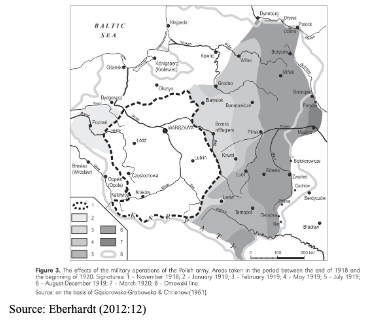
The ‘Polish Question’ had dogged politicians both during the latter stages of World War 1 and at the Treaty of Versailles (Kochanski, 2012) on the future shape of Poland’s borders. Britain had lobbied for the Curzon Line to be adopted to delineate the eastern border, giving some recognition to the independence of Lithuanian, Belorussian and Ukrainian interests. The discourse over Kresy within the geographic region was an ‘itch’ Stalin wanted to scratch. Piłsudski’s land grab and Polonization infuriated the local populous (Rogalski, 2017) with new landlords taking the more fertile land, lucrative government posts and business opportunities. Galicia had been the boundary between the old Tzarist Russia and the collapsed Austro-Hungarian border that enabled Polish claims to have some legitimacy in Piłsudski’s land grab (Eberhardt, 2012).
The following map aids the discussion over the contested border and the variants of the Curzon Line that Stalin resurrected at the Crimean Conference and the subsequent inclusion in the Yalta Agreement February 1945.
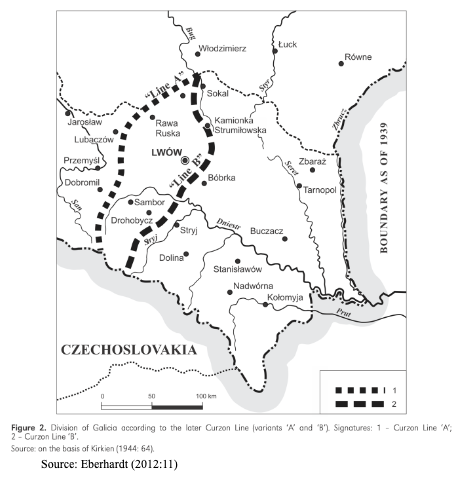
The Soviet View of the Curzon Line 1944:
This map shows a significant variance with the original concept of the Curzon Line by the Soviets. At the Potsdam Conference on 17th July to 2nd August 1945 settled Poland’s western border where much of the gains was ‘compensation’ for lost eastern territories. The Soviets had signed an interim agreement on 26th July 1944 with the Polish Committee of National Liberation (Lublin Committee) that was not binding and not completely legally valid (Eberhardt, 2012) that resulted in a Polish delegation visiting Moscow to correct Soviet demands who wanted to take advantage of the defences around Grodno, hence shifts in the boundaries. While the Soviets ceded the ‘River Bug Bend’ but held fast to many geographic features of Curzon’s original proposal leaving former inhabitants of Kresy in abeyance. Agreement was finally reached on 16th August 1945.
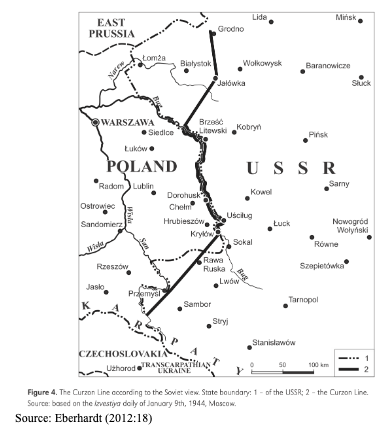
The following map demonstrates the final border and how disputed territories were settled. The settlement gave cold comfort to the survivors of the deportations and the loss of their property or loved ones from Kresy that was never fully recovered, forcing survivors permanently into some form of exile. The importance of Kresy drifted into folklore with younger generations stressing less importance in today’s Poland, leaving the survivors adrift in the nostalgia and cultural heritage of the period.
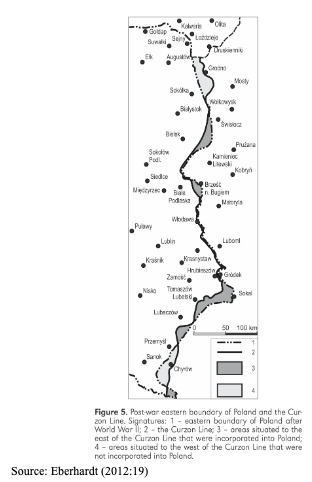
The impact on the deportees must not be forgotten or diminished in their deportation to the gulags and subsequent evacuation to Iran. With the severance of diplomatic relations between Poland and the Soviets in April 1943 due to mistrust, hostility, and suspicion (Orzell, 1976; Piotrowski, 2004; TNA/ HS4-137 to 139) an estimated 500,000 people became ‘lost’ in the Soviet system based in and around the Kolyma and river basin. 200,000 died during the deportations (Piotrowski, 2004) for trading land whose value does not reflect the suffering of the deportees. Jolluck (2002) indicated that although transfer of deportees to Russia ceased in 1948, in the late 1950s another 245,000 were returned to Poland.
The chaos and hardship coupled to high levels of disease and malnutrition with unacceptable death rates had a lasting effect on the survivors (Jolluck, 2002; Jackowska, 2005). The survivors had endured hard labour and meagre rations with forced sex, ‘marriage’ of children and rape being a common practice sometimes in exchange for food (Ciesielski, 1999; Jolluck, 2002). Long lasting distress, anxiety, low self-esteem, depression, and modifications to behavioural relationships in marital and parental roles was a lasting outcome (Jackowska, 2005) that echo in today’s Ukrainian conflict. While the boundary dispute may be settled, the trauma to families and the loss of Kresy is still imprinted on older generations of Poles who were the innocent victims of schisms in ideology and a geopolitical dispute. Coupled to the Katyń Forest Massacre, the deep-rooted animosity towards the Soviets fuelled the anti-communist sentiments that fuelled the political struggle from 1946 until the re-establishment of democracy.
Further Readings:
Ciancia, K. (2019) “The Local Boundaries of the Nation”, Slavic Review, Vol.78, No.3, pp. 671-693.
Eberhardt, P. (2011) “Migracje Polityczne Na Ziemiach Polskich (1939 – 1950”, Polska Akademia Nauk Instytut Geografii I Przestrzennego Zagospodrowania, Poland.
Eberhardt, P. (2012) “The Curzon Line as the Eastern Boundary of Poland: The Origins and the Political background”, Geographia Polinica, Vol.85, No.1, pp. 5-21.
Frank, M. (2008) “Useless Mouths: Transfers from Czechoslovakia and Poland 1946 – 1947”, OUP, UK
Grabowski W. (2009) “Polacy na ziemiach II RP włączonych do III Rzeszy (Poles on the territories of the 2nd Commonwealth incorporated into the Third Reich). Biuletyn Instytutu Pamięci Narodowej, no. 8–9, pp. 61-73.
Hill, A. (2014) “Voroshilov’s ‘Lightning’ War–The Soviet Invasion of Poland, September 1939”, The Journal of Slavic Military Studies, Vo.27, No.3, pp. 404-419.
Jackowska, E. (2005) “Psychological Consequences of Deportation into the Soviet Union on the base of self-reports by Sybiracs”, Psychiatr Pol. Vol. 39, No.1, pp. 89-102.
Kochanski, H. (2012) The Eagle Unbowed: Poland and the Poles in the Second World War”, Allan Lane, UK.
Komaniecka, M; Samonowska, K; Szpytma, M and Zechenter, A. (2013) “Katyn Massacre – Basic Facts “, The Person and the Challenges, Vol.3 No.2, pp. 65-92.
Larkey, U. (2017) “Fear and Terror: The Expulsion of Polish Jews from Saxony/ Germany in October 1938”, Dapim Studies on the Holocaust,
Vol.31, No. 3, pp. 243-260.
Linkiewicz, O. (2014) “Peasant Communities in Interwar Poland’s Eastern Borderlands: Polish Historiography and the Local Story”, Acta Poloniae Historica, Vol. 109, pp. 17-36.
Mędykowski, W.W. (2018) “Macht Arbeit Frei? German Economic Policy and Forced Labor of Jews in the General Government, 1939–1943”, Academic Studies Press, USA.
Mazurkiewicz, J.M. (2021) “Ludobójstwo Niemiec na narodzie polskim (1939–1945). Studium historycznoprawne (Germany’s Genocide against the Polish Nation (1939–1945). Legal Historical Study), Wydawnictwo Instytutu Pamięci Narodowej, Poland.
Moorhouse, R. (2019) “First to Fight: The Polish War 1939”, The Bodley Head, UK
Muskus, U. (2010) “The Long Bridge Out of the Gulags”, Sandstone Press, UK.
Orzell, L. (1976) “Poland and Russia, July 1941-April 1943: The ‘Impossible Alliance’, The Polish Review, Vol.21, No.4, pp.35-58.
Paczkowski, A. (1995)“The Spring Will Be Ours: Poland and the Poles from Occupation to Freedom”, Penn State Press, USA.
Ptaśnik, Z.L.M. (2003) “Death by a thousand cuts – A Polish Women’s Diary of Deportation, Forced Labour and Death in Kazakhstan”, Vol. 1 to 3, Polish Institute of Houston, USA.
Piotrowski, T. (2004) The Polish Deportees of World War II: Recollection of Removal to the Soviet Union and Dispersal Throughout the World”, McFarland & Co, USA.
Rees, L. (2009) “World War II Behind Closed Doors: Stalin, The Nazis and The West”, BBC Books, UK.
Rogalski, W (2017) “Divided Loyalty: Britain’s Polish Ally During the Second World War”, Helion & Co. UK.
Service, H. (2012) “Reinterpreting the Expulsion of Germans from Poland, 1945 - 49”, Journal of Contemporary History, Vol. 47, No. 3, pp.528-550.
Schneidermann, D. (2020) “Berlin, 1933: La presse internationale face à Hitler”, POINTS, France.
Shimomura, A. (2022) “Kresy as the heart of darkness: Reading Polish and Belgian colonialisms”, New Perspectives, Vol. 30, No.4, pp.317-322.
Suvorov, V. (1990) “Icebreaker: Who Started the Second World War?”, Hamish Hamilton, UK.
Williamson, D.G. (2009) “Poland Betrayed: The Nazi-Soviet Invasions 1939”, Pen and Sword, UK.
Additional Useful Resources:
Ciesielski, S. (1996) “Polacy w Kazachstanie w latach 1940 -1946. Zesłańcy lat wojny”, Wydawnictwo Uniwersytetu Wrocławskiego, Poland.
Gawryszewski, A. (2005) “Ludność Polski w XX wieku”, IGiPZ PAN, Poland.
Łuczak Cz. (1993) “Polska I Polacy w drugiej wojnie światowej (Poland and Poles in World War II), Wydawnictwo UAM, Poland.
Martin, D. (1990) “The Web of Disinformation: Churchill’s Yugoslav Blunder”, Houghton Mifflin Harcourt, USA.
Muskus, U. (2010) The Long Bridge Out of The Gulags”, Sandstone Press, UK.
Nielsłuchowski, W. (2022) “Łapanka”, BookPlan.pl, Poland.
Websites:
www.kresyfamily.com
https://mjhnyc.org/blog/the-forgotten-life-of-herschel-grynszpan/
https://ipn.gov.pl/en/news/3822,The-80th-anniversary-of-the-first-mass-deportation-of-Polish-citizens-deep-into-.html
https://rzeszow.ipn.gov.pl/pl8/aktualnosci/143317,Lapanka-w-jaroslawskiej-budowlance-6-maja-1940.html
https://www.zwangsarbeit-archiv.de/en/zwangsarbeit/ereignisse/polenerlasse/index.html
https://www.erih.net/i-want-to-go-there/site/nazi-forced-labour-documentation-centre
https://www.porta-polonica.de/en/atlas-of-remembrance-places/letter-p
https://tvpworld.com/65617404/nazi-industrial-miracle-a-slave-based-economy-exhibition
https://gulag.online/articles/polaci-a-gulag?locale=en#:~:text=In%20consequence%20on%20August%2012th,organized%20by%20general%20Władysław%20Anders
Selected YouTube.com and Film Resources:
“Lost Requiem” (1983) Documentary directed by Khosrow Sinia can be found at: https://www.youtube.com/watch?v=ry5ERzEOU5c.
https://www.youtube.com/watch?v=ry5ERzEOU5c
“Volhynia” (2016) Directed by Wojciech Smarzowski with Michalina Łabacz, Vasyl Vasylyk can be found at:
https://www.youtube.com/watch?v=ry5ERzEOU5c
https://www.youtube.com/watch?v=ry5ERzEOU5c
“Kresy” (The Borderland) (2017) Documentary directed by Rafał Bryll.
https://rzeszow.ipn.gov.pl/pl8/aktualnosci/143317,Lapanka-w-jaroslawskiej-budowlance-6-maja-1940.html
Osborn, J.W. (2016) “Balkan Bedlam: Special Forces in WWII Albania”, Warfare History Network,
warfarehistorynetwork.com
Pepłoński, A and Ciechanowski, J. (2005) “The Role of II Bureauof the Union of Armed Struggle-Home Army (ZWZ-AK) Headquarters in the Intelligence Structures of the Polish Armed Forces”, in The Report of the Anglo-Polish Historical Committee, Vol. 1, pp.108-117.
Petrou, M. (2018) “Melancholy Courage and Peasant Shrewd Cunning”: The Recruitment of Yugolsav-Canadians for Special Operations Executive Missions During the Second World War”, Journal of the Canadian Historical Association, Vol.29, No. 1, pp.
Petrov, B. (2002) “The Monarchy in Albania During World War II”, ÉTUDES BALKANIQUES, No 2, pp.3-14.
Petrov, B. (2006) “Great Britain and resistance in Albania, 1943-1944”, Etudes Balkans, No.2, pp. 87-118.
Petrov, B. (2009) “NATIONAL REPUBLICAN GREEK LEAGUE (EDES), 1941-1944: DISCARDED PRINCIPLES AND AMBIGUOUS ACTIVITIES”, ONAL REPUBLICAN GREEK LEAGUE (EDES), 1941-1, Etudes Balkans, XLV, No.3, pp.3-29.
Petrov, B. (2013) “The Neglected Ally: Zog of Albania in British Plans, Etudes Balkans, XLIX, No.3-4, pp. 38-58.
Przewoźnik, A. (2005) “Hungary” Intelligence Co-Operation Between Poland and Great Britain During World War II”, The Report of the Anglo-Polish Historical Committee, Vol. 1, pp.298-301 and 302-304.
Ritchie, S. (2004) “Our Man in Yugoslavia: The Story of a Secret Service Operative”, Frank Cass, UK/ USA.
West, N. (2014) “Historical Dictionary of British Intelligence”, Rowman and Littlefiled (2nd Edn.), USA.
West, N. (2019) “The story of SOE – Britain’s Wartime Sabotage Organisation”, Front Line Books, UK.
Zaloga, S and Madaj, V. (1991)”The Polish Campaign 1939”, Hippocrene Books, USA..
Zaugg, F.A. (2019) “Resistance and Its opponents in the region of Sandžak and Kosovo”, Les Cahiers Sirice, Vol. 22, No. 1, pp. 85-99.
Zidaru, M. (2020a) “SOE, IASI-CHIȘINĂU OFFENSIVE AND COUP D’ETAT FROM AUGUST 23, 1944”, International Conference KNOWLEDGE-BASED ORGANIZATION, Vol. XXVI, No 2, pp. 366-375.
Zidaru, M. (2020b) “SOE operations in Albania during the Second World War”, Technium Social Sciences Journal Technium Science, vol. 7(1), pp. 289-294.
|